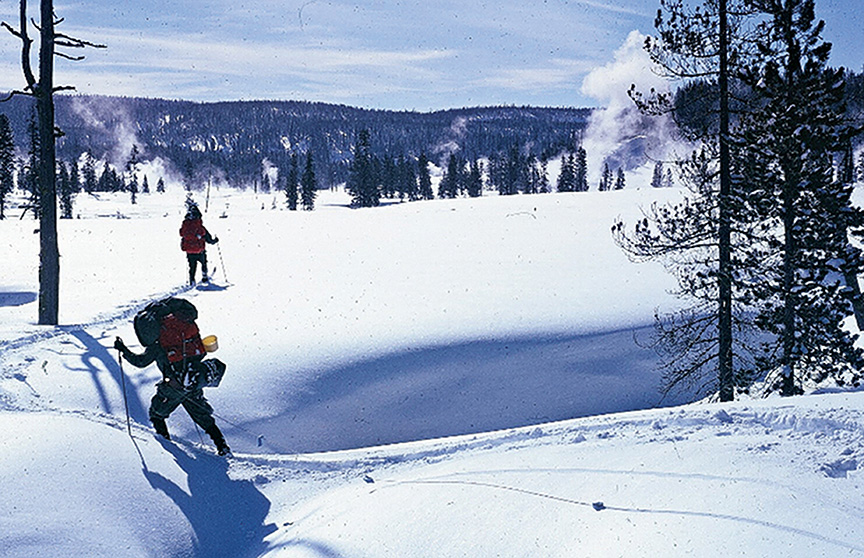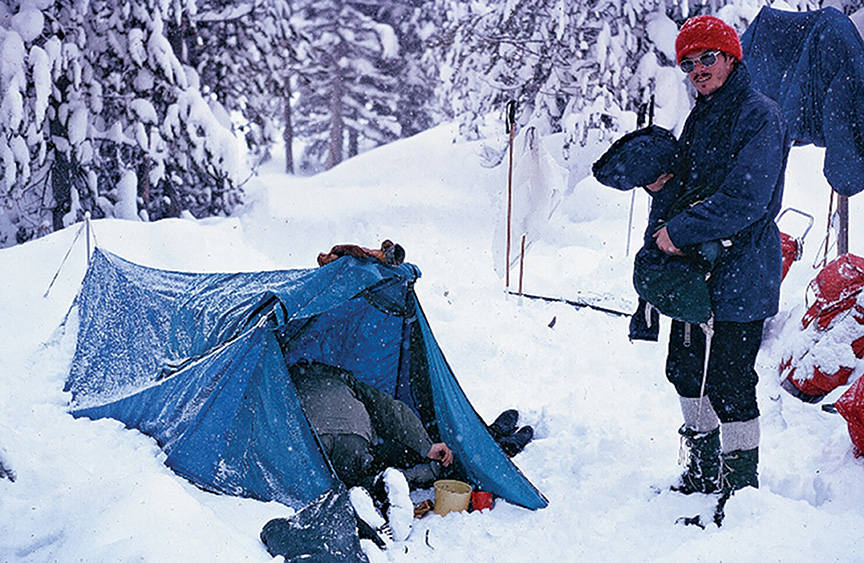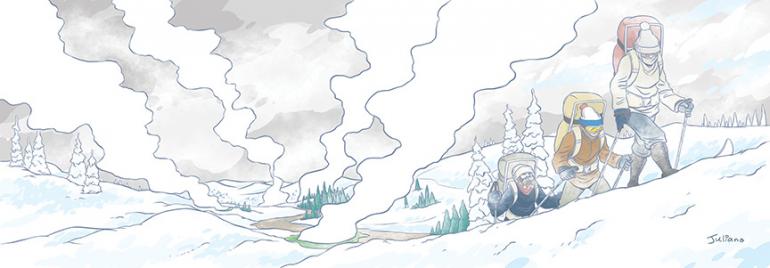When Skis Were Wood & Snow Was Deep
A Yellowstone ski tour.
In February of 1974, I embarked on an 18-day ski trip through Yellowstone that coincided with a strong La Nina weather event, producing some of the deepest snow in decades. My skis were waxable wooden Tronderskis with lignostone edges. My boots were the high-top leather variety greased up with snow-seal, and they fit a heavy-duty, three-pin metal 79mm binding. My canvas gaiters were purchased from the Army Surplus store, and my ski poles were made of bamboo. My companions, Steve Veltrie of Spokane and Brian Severin of Great Falls, were both strong skiers, so we had mapped out an ambitious trip that would take us past some of the Park’s wildest country, visiting the geyser basins at Shoshone and Heart lakes, skirting Yellowstone Lake, and heading north to the Lamar Buffalo Ranch, where we had left a food cache. From there we would head west, eventually passing through the Black Canyon of the Yellowstone River, and exiting the Park at Gardiner.
On a clear, cold mid-February morning, we headed out from Old Faithful in high spirits carrying heavy packs loaded with gear and freeze-dried food. The metal orange trail markers, helpful at first, soon disappeared as our packed trail gave way to deep, untracked snow through forested meadows. Our ski-touring was reduced to “ski-shoeing,” and we didn’t reach Grants Pass, at an elevation of 8,000 feet, until just before darkness had settled into the woods. After stomping out a flat spot with our skies, we pitched our three-man Frostline tent (sewn by my wife Margaret from a kit), slipped into our warm cocoons, and ate a hearty meal of beef and potatoes. Then we were content to soak in the silence and drift off to sleep—it felt great to be back in the wilderness.
 Traveling Yellowstone's expanse, one step at a time.
Traveling Yellowstone's expanse, one step at a time.
The next day, navigating by map and compass, we took turns breaking trail through the deep snow and finally found our way to Shoshone Geyser Basin. The contrast of mushrooming clouds of steam against the deep-blue, frigid skies was magnificent. The following morning, however, fog from the nearby geyser basin would not burn off, and with the temperature 20 below, it was tough to break camp, resulting in a late start. By late morning, deep blue skies emerged, and we made good progress until we reached the east end of Shoshone Lake, at which time we noticed a strange change in the weather. The wind picked up and the temperature climbed to a balmy 36 degrees. We managed to locate one of the two patrol cabins we had been given permission to use during our trip, and dug through five feet of snow to enter the cozy structure. We promptly decided to spend a rest day there, washing and drying our clothes and ourselves. Late that afternoon a heavy snow began to fall. We had no idea that this snowstorm was to continue, off and on, for the next thirteen days.
Two days later, having left the shelter of the cabin, we skied under miserable conditions through a driving storm that quickly produced two feet of new snow. After skirting Lewis Lake and crossing the desolate, untracked south entrance road, we trudged three miles along the Heart Lake trail before making camp in a dense lodgepole forest—we had covered only eight miles for the day.
The following morning held some promise; the sky was merely overcast. The snow had stopped falling, at least for the time being. We soon came upon a beautiful overlook of the frozen expanse of Heart Lake, followed by a plethora of colorful thermal pools along Witch Creek. We passed a herd of seven elk taking advantage of the warm microclimate. Given the remoteness of our magical setting, we imagined we were early trappers, exploring unknown wild country.
We had planned to stay at the Heart Lake patrol cabin for two days, resting up and exploring the thermal basins, before continuing our journey; but the weather gods had other plans. During the middle of the night, a blizzard began that would last for the next six days, dumping several feet of snow. The winds shrieking across Heart Lake in the middle of the night toppled the latrine near the cabin, and even blew open the cabin door.
 Roughin' it, '74 style.
Roughin' it, '74 style.
By noon the next day, I grew tired of playing cards and headed out by myself in the raging snow and wind to ski around the geyser basin. As I neared Rustic Geyser, I encountered a large, dark-colored canine—a wolf! The sly creature quickly darted off into the woods. I later learned that Yellowstone did not officially have any wolves in the Park at that time, so perhaps this was a solo wolf passing through looking for weak elk in the basin.
After four days, the storm had not abated, so with the visibility at zero, we attached avalanche cords (long orange ribbons intended to help locate avalanche victims) and headed out across Heart Lake. There was no differentiating between ground and sky—it was all one huge white screen, as we followed our compass into the powerful headwinds. Once across the lake we committed a devastating error: we turned down the wrong drainage and followed it for a couple of miles before realizing our mistake. Even with our backcountry skis, we were sinking up to our knees in the deep snow. The elements had won. Given our work schedules, we knew we could not complete the trip as planned. Sadly, we retraced our route back to the cabin.
It took us two days to trudge eight miles to the south entrance road, which had been closed to any over-snow travel due to the blizzard and deep snows. It took us another day to reach Grant, where Ranger Paul Miller put us to work shoveling roofs in exchange for putting us up for the night. With his help, we caught a snow coach going north and eventually made it to our cache at the Lamar Buffalo Ranch. The weather cleared and we managed to finish our journey, skiing into the Black Canyon, then attaching our skis to our packs and hiking the rest of the way along the Yellowstone River. The hardships were soon forgotten, but the memories of 18 days in Yellowstone’s otherworldly winter wilderness will always linger with us.
Note: the NPS no longer allows visitors to use patrol cabins.
Orville Bach has been a seasonal ranger in Yellowstone for over 40 years.









